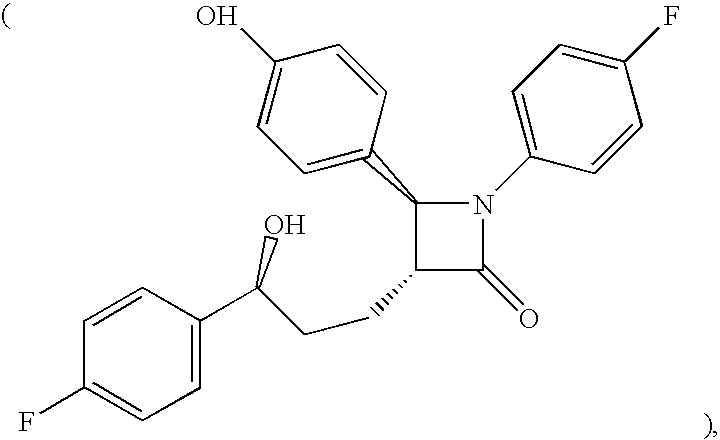NPC1L1 (NPC3) and methods of use thereof
a technology of npc1l1 and polypeptides, applied in the field of npc1l1 polypeptides and polynucleotides, can solve the problems of cholesterol accumulation, delayed cholesterol relocation, and inability to carry cholesterol,
- Summary
- Abstract
- Description
- Claims
- Application Information
AI Technical Summary
Benefits of technology
Problems solved by technology
Method used
Image
Examples
example 1
Cloning and Expression of Rat, Mouse and Human NPC1L1.
[0168]Rat NPC, mouse NPC1L1 or human NPC1L1 can all conveniently be amplified using polymerase chain reaction (PCR). In this approach, DNA from a rat, mouse or human cDNA library can be amplified using appropriate primers and standard PCR conditions. Design of primers and optimal amplification conditions constitute standard techniques which are commonly known in the art.
[0169]An amplified NPC1L1 gene may conveniently be expressed, again, using methods which are commonly known in the art. For example, NPC1L1 may be inserted into a pET-based plasmid vector (Stratagene; La Joola, Calif.), downstream of the T7 RNA polymerase promoter. The plasmid may then be transformed into a T7 expression system (e.g., BL21DE3 E.coli cells), grown in a liquid culture and induced (e.g., by adding IPTG to the bacterial culture).
example 2
[0170]Membrane preparation: Caco2 cells transfected with an expression vector containing a polynucleotide encoding NPC1L1 (e.g., SEQ ID NO: 2, 4 or 12) are harvested by incubating in 5 mM EDTA / phosphate-buffered saline followed by repeated pipeting. The cells are centrifuged 5 min at 1000×g. The EDTA / PBS is decanted and an equal volume of ice-cold 50 mM Tris-HCl, pH 7.5 is added and cells are broken up with a Polytron (PT10 tip, setting 5, 30 sec). Nuclei and unbroken cells are sedimented at 1000×g for 10 min and then the supernatant is centrifuged at 50,000×g for 10 min. The supernatant is decanted, the pellet is resuspended by Polytron, a sample is taken for protein assay (bicinchoninic acid, Pierce), and the tissue is again centrifuiged at 50,000×g. Pellets are stored frozen at −20° C.
[0171]Binding assay: For saturation binding, four concentrations of [3H]-ezetimibe (15 Ci / mmol) are incubated without and with 10−5 M ezetimibe in triplicate with 50 μg of membr...
example 3
SPA Assay.
[0172]For each well of a 96 well plate, a reaction mixture of 10 μg human, mouse or rat NPC1L1-CHO overexpressing membranes (Biosignal) and 200 μg / well YSi-WGA-SPA beads (Amersham) in 100 μl is prepared in NPC1L1 assay buffer (25 mM HEPES, pH 7.8, 2 mM CaCl2, 1 mM MgCl2, 125 mM NaCl, 0.1% BSA). A 0.4 nM stock of ligand-[125I]-ezetimibe- is prepared in the NPC1L1 assay buffer. The above solutions are added to a 96-well assay plate as follows: 50 μl NPC1L1 assay buffer, 100 μl of reaction mixture, 50 μl of ligand stock (final ligand concentration is 0.1 nM). The assay plates are shaken for 5 minutes on a plate shaker, then incubated for 8 hours before cpm / well are determined in Microbeta Trilux counter (PerkinElmer).
[0173]These assays will indicate that [125I]-ezetimibe binds to the cell membranes expressing human, mouse or rat NPC1L1. Similar results will be obtained if the same experiment is performed with radiolabeled cholesterol (e.g., 125I-cholesterol).
PUM
| Property | Measurement | Unit |
|---|---|---|
| Electrical conductance | aaaaa | aaaaa |
| Capacitance | aaaaa | aaaaa |
| Dynamic viscosity | aaaaa | aaaaa |
Abstract
Description
Claims
Application Information
 Login to View More
Login to View More - R&D
- Intellectual Property
- Life Sciences
- Materials
- Tech Scout
- Unparalleled Data Quality
- Higher Quality Content
- 60% Fewer Hallucinations
Browse by: Latest US Patents, China's latest patents, Technical Efficacy Thesaurus, Application Domain, Technology Topic, Popular Technical Reports.
© 2025 PatSnap. All rights reserved.Legal|Privacy policy|Modern Slavery Act Transparency Statement|Sitemap|About US| Contact US: help@patsnap.com


